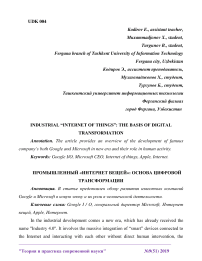Industrial “internet of things”: the basis of digital transformation
Автор: Kodirov E., Muxammadjonov X., Turgunov B.
Журнал: Теория и практика современной науки @modern-j
Рубрика: Основной раздел
Статья в выпуске: 9 (51), 2019 года.
Бесплатный доступ
The article provides an overview of the development of famous company’s both Google and Microsoft in new era and their role in human activity.
Google i/o, microsoft ceo, internet of things, apple, internet
Короткий адрес: https://sciup.org/140274929
IDR: 140274929 | УДК: 004
Текст научной статьи Industrial “internet of things”: the basis of digital transformation
In the industrial development comes a new era, which has already received the name "Industry 4.0". It involves the massive integration of “smart” devices connected to the Internet and interacting with each other without direct human intervention, the collection and processing of large amounts of data, self-learning systems based on artificial intelligence, virtual and augmented reality, as well as a number of other new technologies that today increasingly are used in modern enterprises. One of the key elements of the Fourth Industrial Revolution is the so-called Industrial Internet of Things (Industrial Internet of Things, IIoT). Unlike the usual “Internet of Things”, which includes wearable devices for end users, elements of “smart home”, unmanned vehicles, etc., IIoT consists of two main parts. These are smart sensors and sensors that are used to equip industrial equipment, machine tools, conveyors, assembly lines, elements of engineering infrastructure, robots, as well as analytical platforms for collecting data that come from connected devices.

What is the advantage of IIoT for enterprises? First of all, we are talking about reducing the cost of equipment maintenance. Machines and other devices equipped with autonomous sensors capable of transmitting information via the Internet promptly notify about various failures and malfunctions in their work, which helps in a timely manner to fix problems, avoid downtime and costly repairs. Warehouse IIoT solutions analyze the availability of stocks, allow you to independently order the missing materials and spare parts. IIoT has enormous potential in security. "Smart" cameras and sensors are able to identify abnormal situations and respond to them independently, or promptly notify security officers. These are just some of the possible areas where IIoT not only can be used, but is already actively used.
The IIoT market in world is growing rapidly. According to the results of a study conducted in 2018 by Tadviser together with its volume (equipment, robotic systems, sensors, software and platforms, infrastructure and networks, integration and other services) in 2017 amounted to 93 billion rubles. and is projected to rise to 270 billion by 2020. The share of industry spending is about 20% (increase to 25% by 2020). The revitalization of the IIoT market will be largely determined by state support.
New opportunities
As for new models and approaches to enterprise management, which provide customers with IIoT solutions the industrial “Internet of things” is primarily a transition to a new level of end-to-end automation of production and business processes. And not only within the framework of a single workshop or enterprise, but throughout the entire life cycle: from the idea and prototyping to production and disposal. The use of digital models and digital technologies allows much better, faster and more efficient cooperation between production and business.
Until the thunder clap
The devices of the industrial “Internet of Things” interact with each other and transmit data to the analytical platform not in some kind of secure “sandbox”, but in the real Internet, where we all live and work. How safe are the IIoT technologies in their current state of development? “Obviously, if the company broke a pipe and a hazardous substance leaked, it is a disaster. However, if an event occurred that we did not consider when programming the software, or the system behaved incorrectly, the result would also be catastrophic. The criminals, whose goal is to create such a situation in the enterprise, not only attack physical objects, but also try to disrupt the work of the program part. Therefore, it is important not only to build fences around factories, but also to build barriers for intruders trying to penetrate the software part. At the moment the development of IIoT technologies, security is still being given, if not enough, then not so much attention, since the “scale of the disaster” is not so great that it is seriously considered. “There are standard security threats, protection against DDos attacks, system software infections, but these issues are resolved at the level of general security principles,” he explains. Then in the case of IIoT - at the level of a specific system, which are now fragmented and narrow and for hacking the data of some counter you need to do a huge job and to spend on it some big money is simply not profitable. However, when the industry comes to more widespread use of IIoT and the use of platforms, the threat will increase in severity. There is channel protection, antivirus, cryptography. All this needs to be simply adapted for IIoT and, I think, many are already engaged in this, especially where there is a large and serious data stream”.
The IIoT market in the world and in the world is at the initial stage of development, but it is already actively gaining momentum. Customers are interested in increasing efficiency, this is a constant task that needs to be addressed daily, and therefore IIoT technologies cause their continued interest. So far, many questions remain regarding integration with existing systems, the definition of performance indicators, the choice of specific platforms and products. There is something to focus on as developers and system integrators.
Список литературы Industrial “internet of things”: the basis of digital transformation
- Global navigation satellite system GLONASS / Ed.B.N. Kharisova, A.I. Petrova, V.A. Boldin, 2nd ed., Moscow: IPZhR, 1999, 560 p.
- Antonovich K.M., Karpik A.P. Monitoring of objects with the use of GPS-technologies // Journal: News of higher educational institutions. Surveying and aerial photography. Ed.: MGUGiK, 2004. No. 1- p. 53-67.


